Excerpt from doctoral thesis: Beyond the Space of Painting and Poetry: Mallarmé and the Embodied Gesture, 2020.
‘Mallarmé Me Meillassoux’, is one of twelve chapters recounting a series of imagined dialogues between Mallarmé, ‘Me’, and selected poets, painters, and philosophers who have responded to Stéphane Mallarmé’s generative poem, Un coup de Dés jamais n’abolira le Hasard, (A throw of the Dice will never abolish Chance). The dialogues weave together my words, words appropriated from Mallarmé’s poems, prose, and letters, and the words of selected poets, painters, and philosophers. These acts of appropriation and re-contextualisation question the role of context as a register of meaning. The dialogues can be seen as constellations operating across space and time – challenging the convention of an art historical context determined by narrative sequence. In the context of these configurations or points of convergence, meaning can never be fixed.
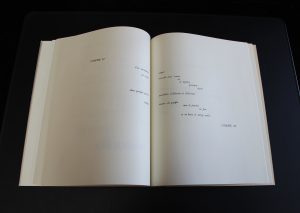 Fig 1.
Fig 1.
We stand facing the sea, ‘to gaze at what lies beyond our daily existence, which is to say infinity and nothingness’.[1] I consider this pale and indistinct line as it curves away from me, separating the sea from sky; the earth from the heavens. I imagine a second line, the sine of an arc extending from the ground to my right, to a point above my head, the perpendicular, and from here to a point on my left as it inscribes an arch, the arc of an angel, a messenger in the sine of x.
My thoughts turn to the origin of the word sine, to jayb, chosen by the Arabs to designate the half-cord of the double arch.[2] The cord is formerly inscripta, the inscribed line. I wonder about this curve, this perfect line, insinuated in Un coup de Dés. I see that the poem operates under the sign of ‘si’ contained in ‘in(si)nuation’, a sign that proliferates in the centre pages of Un coup de Dés, in and across translation [Fig.1].[3]
This ‘simple insinuation’ is an ironic play. The small italic font betrays its significance. In the preface to Un coup de Dés, Mallarmé writes: ‘the different type face between the principal theme, a secondary one, and adjacent ones, dictates their level of importance when uttered orally’.[4] Mallarmé’s insinuation, whispered perhaps, carries an official seal, implying a solemn occasion, a ceremony, and permanent record.
The words ‘COMME SI | COMME SI’, (‘AS IF / AS IF’) join to form an ornate clasp, the signatory seal of the poem. I picture the S of SI entwined with the S of the second SI – a whirlpool. Two sixes coiled together to form a circle, now a figure of eight, which if turned on its side reveals the symbol for infinity.  The figure of the siren (‘siren sinuosity’) [5] rises in the letter S, which is linked to the letter f, signified in the solitary plume, ‘an utterly lost and lonely quill.’ [6] The quill pen, a flight feather, links by association flight and swan, script and manuscript, the plume of Hamlet’s cap, and song.[7] In ‘COMME SI / COMME SI’ and AS IF /AS IF’, the s and f, recall the shape of the hole carved into the sound board of a violin, a symbol that also appears in pairs in Mallarmé’ handwritten manuscript.
The figure of the siren (‘siren sinuosity’) [5] rises in the letter S, which is linked to the letter f, signified in the solitary plume, ‘an utterly lost and lonely quill.’ [6] The quill pen, a flight feather, links by association flight and swan, script and manuscript, the plume of Hamlet’s cap, and song.[7] In ‘COMME SI / COMME SI’ and AS IF /AS IF’, the s and f, recall the shape of the hole carved into the sound board of a violin, a symbol that also appears in pairs in Mallarmé’ handwritten manuscript.


Music and letters, signified in SI, in the song of the siren, and in a final gesture, the ‘Swan song’ is repeated and doubled in Mallarmé’s letters, in the sound of alliteration.[8]
Word, image, and sound coalesce; the circle suggests a male and female principle, in the form of ying and yang, day and night are invoked, as are black and white, unleashing a whirlpool of binary relations. Symbols are conjured and doubled in letters, syllables, words, and sounds, as they emerge across the centre pages of Un coup de Dés. A doubling that culminates in the vortex, ‘in some immanent swirl of hilarity and horror,’[9] the mystery is performed and revealed, simultaneously presenting a vortex and a dome, a celestial constellation recalling Sandro Botticelli’s Eighth Sphere (Heaven of The Fixed Stars)[10], [Figs 2 and 3 ].
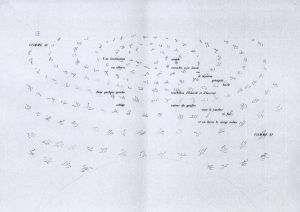 Fig. 2
Fig. 2
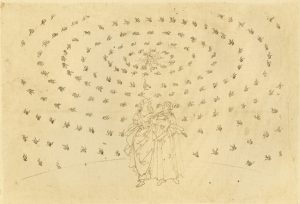 Fig.3
Fig.3
Turning to Mallarmé, I say: ‘The French word ‘indice’ from the line “et en berce vierge indice”, (“and draws from it the soothing virgin sign’”),[11] which translates as sign also means ‘clue’ or ‘index’. ‘Indice’, sounds like the English words ‘in dice’ – in this associative chain linking French and English words, sign, clue, and index become synonymous with dice. Your symbolic gesture, like the “throw of the dice”– begins a corresponding movement that unites sign and symbol – initiating temporal and spatial sequences, manifest both in the dice and beyond their delineated space.[12] In my reading, this dynamic play gives rise to a three-dimensional mathematical model, a codex generating infinite configurations in time and space.’
I hesitate for a moment, before continuing. ‘I imagine this principle applied to the twelve double pages of Un coup de Dés. I see how you establish your “simultaneous vision of the page,’ how these apparently broken chains link and expand in the white space, forming a series of ellipses. These expand and contract into spheres, dynamic bodies, whose movement is simultaneously linear and rotational. Each movement is performed along this arc, as a series of waves emanate from the centre. In Un coup de Dés, this becomes manifest in the violence of the storm, in the maelstrom, “in some immanent swirl of hilarity and horror.”[13] In the vortex numbers and letters are implied, zeros and o’s, and by extension, holes and wholes. The paradox of presence and absence resurfaces, and I think your idea of the book, “a real book architectural and premeditated, and not a collection of chance inspirations however wonderful”.’ Mallarmé’s words merge with my thoughts.
‘The orphic explanation of the Earth,’[14] he replies, smiling.
The tone of his voice pulls me from my musing to “this pale and indistinct line.” [15]We are standing still, eyes fixed on a point in the distance. How long have we been standing here? I wonder. How long has Mallarmé been speaking?
Bernadette O’Toole.
[1] Mallarmé, Mallarmé on Fashion: A Translation of the Fashion Magazine La Dernière Mode, with Commentary, P. N. Furbank and Alex Cain, Oxford, Berg Oxford International Publishes Ltd, 2004, p. 56, [La Dernière Mode, O. C., p. 732.]
[2] Victor J. Katz writes: ‘The word sine comes from a Latin mistranslation of the Arabic jiba, which is a transliteration of the Sanskrit word for half the chord, jya-ardha’. (Katz, A History of Mathematics, Boston: Addison-Wesley, 2008, 3rd. ed., p. 253).
[3]See also, Meillassoux’s reading of ‘Si’ in ‘insinuation’, being equal to the seventh note of the ‘sol-fa’ musical scale. Quentin Meillassoux, The Number and the Siren: A Decipherment of Mallarmé’s Coup de Dés, translated by Robin Mackay, New York, NY: Urbanomic/Sequence Press, 2012., p.66, [Le Nombre et la sirène, Paris: Fayard, 2011]
[4] Mallarmé, preface to Un coup de Dés, Stéphane Mallarmé: Collected Poems and Other Verse, with parallel French text, translated by E. H. and A. M. Blackmore, Oxford: Oxford University Press, 2008 [2006] p.263. Italic type is linked to the handwritten note, to cursive script and the signature, and by association the hand of the artist and line. The question of authority and of authorship is signalled and paralleled in Mallarmé’s linguistic act. In a letter to Paul Verlaine, Mallarmé refers to his ‘fragment’ [Un coup de Dés] as ‘anonymous since the text would speak by itself and without the author’s voice’. (See, Letter to Paul Verlaine, numbered 103, Stéphane Mallarmé, Selected Letters of Stéphane Mallarmé, translated by Rosemary Lloyd, Chicago IL: Chicago University Press, 1988, November 16, 1885, pp.142–6, 144) Mallarmé’s letter in my opinion signifies the book to come, a self-generating book of letters and by association numbers.
[5] Op. cit., Mallarmé, Un coup De Dés, Stéphane Mallarmé: Collected Poems and Other Verse, p. 174.
[6] Ibid., p.172
[7] Ibid. The figure of Hamlet is conjured up in the line ‘a bitter prince of the reef.’ Hamlet’s hat and plume are separated in the storm, ‘that cap of midnight…the velvet crumpled’, and ‘an utterly lost and lonely quill’, paralleling the separation of the master (poet) ‘a corpse cut off by its arm from the secret it withholds’, implying a separation between mind and body.
[8] The Swan Song, from the ancient Greek κύκνειον ᾆσμα; Latin carmen cygni, defined as a metaphorical phrase for a final gesture, effort, or performance given just before death (OED) In Mallarmé the swan is emblematic of Mallarmé’s poetic vision.
[9] Ibid., pp. 170-71.
[10] In Fig. 2, words from the centre pages of Un coup de Dés, are place over a drawing of Sandro Botticelli, Paradiso XXVI, The Fixed Stars, [Fig.3, one of a series of drawings illustrating the cantos from Dante’s Divine Comedy]. In the Eighth sphere (heaven of fixed stars); Beatrice entreats St. Peter to examine her ward in true faith, the prime theological virtue; Dante\’s confession of faith. Sandro Botticelli, c.1480–c1495. Zeichnungen von Sandro Botticelli zu Dantes Göttlicher Komödie; verkleinerte Nachbildungen der Originale im Kupferstich-Kabinett zu Berlin und in der Bibliothek des Vatikans; mit einer Einleitung und der Erklärung der Darstellungg hrsg. von F. Lippermann. Berlin: G. Grote, 1921.
[11] Op. cit., Mallarmé, Un coup de Dés, pp. 170-71.
[12] See, Mallarmé’s ‘abstract vision,’ ‘That music and letters are two sides of the same coin; here extending into obscurity; there dazzling with clarity; alternative sides to the one and only phenomenon I have called the Idea’. (Mallarmé, ‘Music and Letters’, in Divagations, translated by Barbara Johnson, Cambridge, MA: Harvard University Press, 2009, pp. 173–98, 189. [Divigations, Paris: Bibliotheque-Charpentier, 1897].
[13] Op. cit., Mallarmé, Un coup de Dés, pp. 170-71.
[14] Op. cit., Mallarmé, Letter to Paul Verlaine, 15 November 1885, Stéphane Mallarmé, ‘Autobiography’, Divagations, pp. 1-6, 3.
[15] Op. cit., Mallarmé, Mallarmé on Fashion, p. 56

M.B. O’Toole. On Some Death Throe. ‘Painting Doesn’t Count’. Bridewell Studio Gallery, Liverpool. 2021. Photograph Fiona Filby.
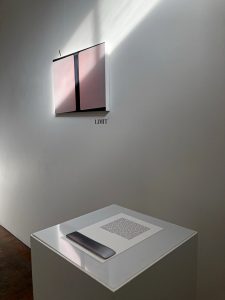
M.B. O’Toole. On Some Death Throe. ‘Painting Doesn’t Count’. Bridewell Studio Gallery, Liverpool. 2021. Photograph Fiona Filby.
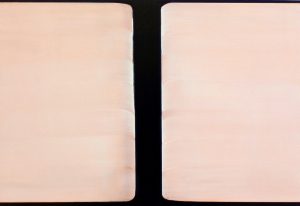
M.B. O’Toole. Variant Sail #1 (I of XII paintings). Oil on panel. 56cm x 3cm.

M.B. O’Toole, Digital image showing a cumulative syllabic count of Un coup de Dés in numbers, 2017.
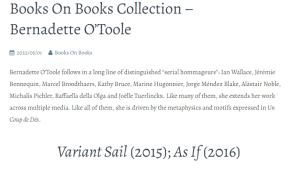
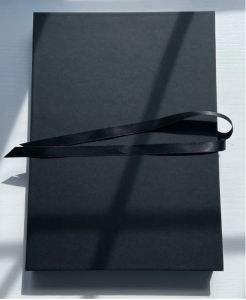
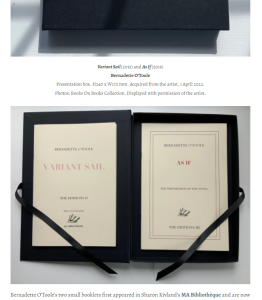
M.B O’Toole. Books on Books. 2022.
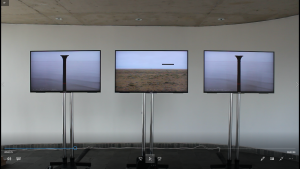
M.B. O’Toole. Multiple Video Installation. Sheffield Institute of the Arts, Yorkshire Arts Space. 2018
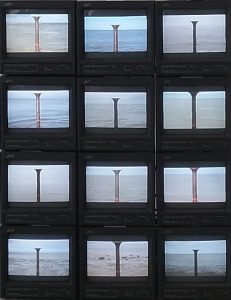
M.B. O’Toole, Resurrecting I, Video Installation, 12 mins duration ( 2016-18). Sheffield Institute of the Arts, Yorkshire Arts Space. 2018.
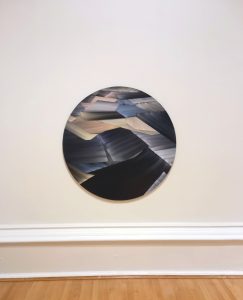
M.B. O’Toole, Gesture Series II, (painting 2), ‘Refractive Pool’. Walker Art Gallery, Liverpool. Oil on board, 120cm diameter, 2021.
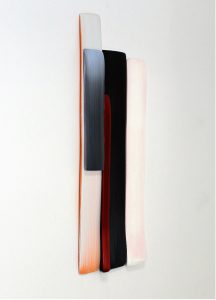
M.B. O’Toole, Gesture Series II. ‘Refractive Pool”. Walker Art Gallery, Liverpool. Oil on plaster. Dimensions Variable.

M.B. O’Toole, Gesture Series II. ‘Refractive Pool”. Walker Art Gallery, Liverpool. Oil on plaster. Dimensions Variable.
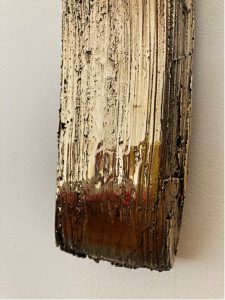
M.B. O’Toole, detail of ‘Gesture’, bronze, On Some Death Throe, ‘Painting Doesn’t Count’, Bridewell Studios, 2021. Photograph, Fiona Filby.